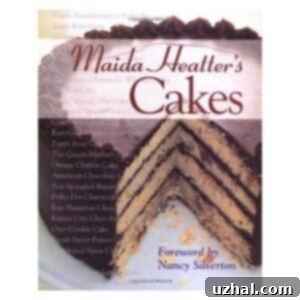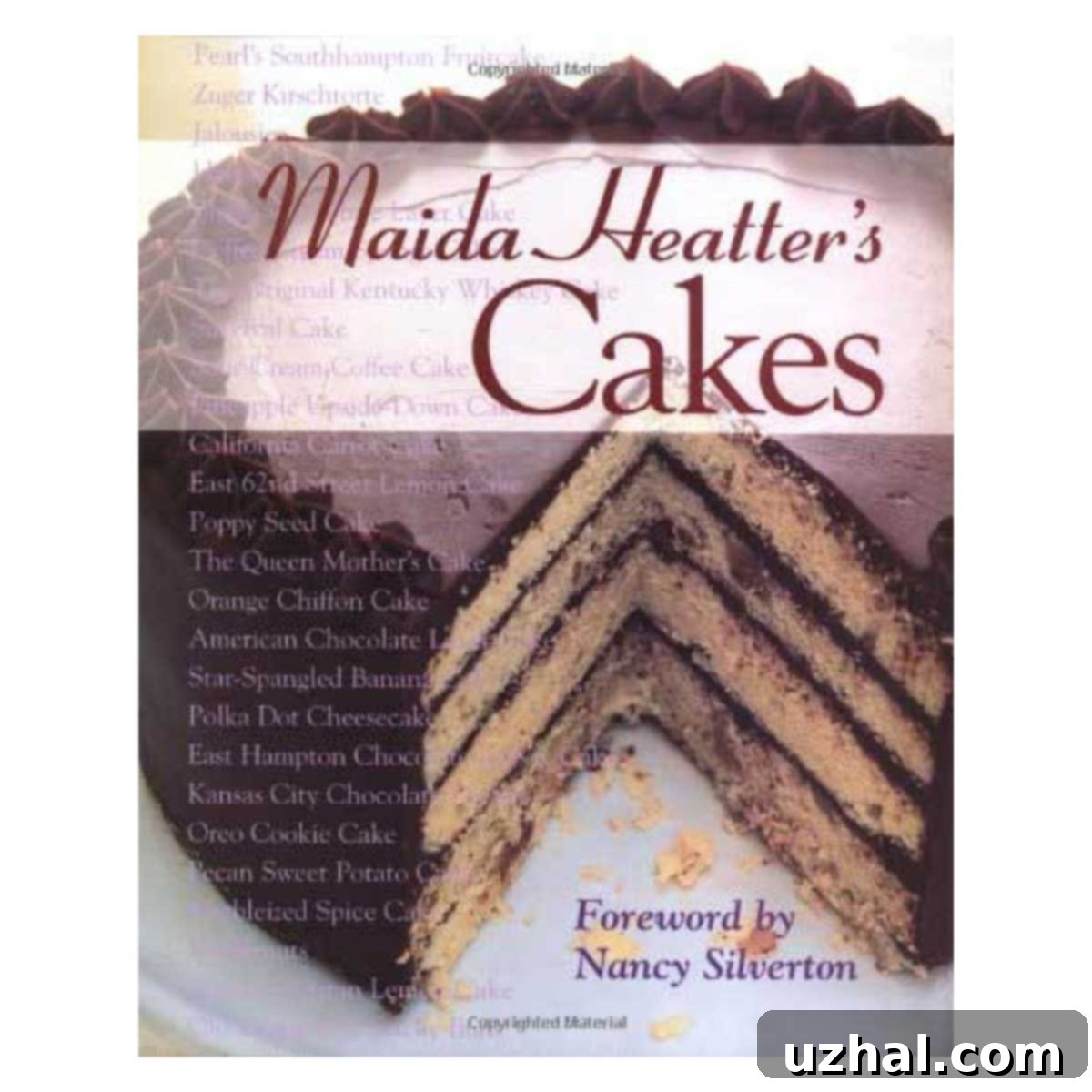Maida Heatter’s Classic Pound Cake: A Timeless Recipe for Pure Buttery Perfection
Years ago, in a burst of Halloween enthusiasm and perhaps a lapse in culinary judgment, I embarked on a mission to “enhance” Maida Heatter’s iconic pound cake. My secret weapon? A generous handful of festive Halloween Oreos, their vibrant orange filling promising a spooky twist.
The outcome, while undeniably delicious, was a visual spectacle. Those cheerful orange cookie fragments transformed an otherwise elegant, golden-hued, buttery cake into a dessert that, frankly, resembled a culinary construction site mishap. It was a chaotic symphony of flavors, certainly, but far from the dignified simplicity that Maida Heatter’s recipes are celebrated for.
Today, we embark on a journey of redemption, giving this truly incredible cake the reverence and respect it has always deserved. We’re returning to its roots, embracing the pure, unadulterated brilliance of Maida’s original vision. There will be no Oreos, no distracting gimmicks, no unnecessary frills. Just the harmonious blend of butter, sugar, flour, eggs, and the sublime essence of vanilla and almond, culminating in a cake of unparalleled perfection. This is pound cake as Maida intended it: a testament to the beauty of foundational baking.
Of course, for those adventurous souls who harbor a nostalgic fondness for that chaotic Halloween Oreo experiment, I’ll discreetly avert my gaze. But for now, let’s celebrate the timeless classic.
The Legacy of Maida Heatter and the Enduring Appeal of Pound Cake
Maida Heatter, often hailed as the “Queen of Cakes,” was a baking legend whose meticulously tested recipes and straightforward approach inspired countless home bakers. Her philosophy was simple: use the best ingredients, follow the steps precisely, and the results would be extraordinary. Her classic pound cake is a prime example of this philosophy in action. It’s not just a cake; it’s a culinary landmark, representing the pinnacle of simple elegance.
The very term “pound cake” derives from its original recipe calling for a pound each of butter, sugar, eggs, and flour. This humble origin belies its rich flavor and incredibly moist, dense, yet tender crumb. It’s a cake that requires no fancy frosting or elaborate decorations to shine. Its beauty lies in its pure, unadulterated taste and satisfying texture, making it a beloved dessert that transcends trends and generations, perfectly suitable for an elegant tea party or a comforting family gathering.
Embracing the Classic: The Pure Pound Cake Version
For those discerning bakers who appreciate the unadorned beauty of Maida Heatter’s creation, opting not to introduce extraneous ingredients like Oreos, here is the pristine version of this beloved pound cake as I meticulously prepare it. While this recipe is a faithful rendition, capturing the essence of Maida’s genius, for her precise, non-paraphrased original formulation, a treasured copy of Maida Heatter’s Great Cakes remains an invaluable resource. This essential cookbook is a cornerstone for any serious baker, offering timeless recipes and unparalleled insights that have stood the test of time.
Essential Tips for Baking a Flawless Pound Cake
While the concept of pound cake might appear straightforward, it’s the meticulous attention to a few crucial details that truly elevates it from good to extraordinary. Mastering these subtle nuances will ensure your pound cake boasts that signature moist crumb and perfectly golden crust every time.
- Temperature Matters: Room Temperature Ingredients are Key. This cannot be stressed enough. Ensure your butter, eggs, and sour cream are at a cool room temperature – think soft enough to indent with a finger, but not greasy or melted. Ingredients straight from the refrigerator will cause your batter to curdle and separate, leading to a dense, inconsistent cake. Conversely, overly warm ingredients can result in a greasy texture. Aim for about 68-70°F (20-21°C) for optimal blending.
- Creaming Butter and Sugar Properly. This step is foundational for a light, airy pound cake. Cream the softened butter and granulated sugar together on medium speed for several minutes until the mixture becomes visibly light, fluffy, and pale in color. This vigorous mixing process incorporates tiny air pockets, which act as a natural leavener, contributing to the cake’s tender crumb. Avoid the temptation to use high speed, which can over-aerate the butter and lead to “sad streaks”—dense, gummy lines in your finished cake caused by an unstable emulsion.
- Precise Dry Ingredient Measurement. For consistent results, especially with delicate baking like pound cake, it’s always best to weigh your flour and sugar using a digital kitchen scale. Volume measurements (cups) can vary significantly depending on how ingredients are packed, leading to a dry or overly dense cake. If you don’t have a scale, lightly spoon flour into your measuring cup until it overflows, then level it off with a straight edge, rather than scooping directly from the bag and compacting it.
- Don’t Overmix the Batter. Once you begin adding the flour and sour cream, mix only until just combined. Overmixing flour develops tough gluten strands, which will result in a dry, chewy cake instead of the tender crumb we’re aiming for. A heavy-duty rubber scraper or spatula is ideal for the final folds to ensure everything is just blended without excessive agitation.
- Patience During Cooling. Resist the urge to unmold your cake immediately after it comes out of the oven. Allow the pound cake to rest in its pan for approximately 15 to 20 minutes. This crucial resting period allows the cake to firm up slightly and settle, making it less fragile and preventing it from cracking or breaking when you invert it onto a wire rack. This helps it maintain its beautiful Bundt or tube pan shape.
- Choosing the Right Pan. If possible, opt for a light-colored metal Bundt or tube pan. Darker pans absorb more heat and can lead to overbrowning or even burning of the exterior before the interior is fully cooked. A well-greased and floured pan is also non-negotiable for an easy release, ensuring your beautifully baked cake comes out intact.
- Know Your Oven. Oven temperatures can vary significantly. Consider using an oven thermometer to ensure your oven is truly at the temperature you set. An accurately calibrated oven is vital for even baking and proper browning.
- Crispy Oatmeal Bars
- Mini Halloween Oreo Cheesecakes
- M&M Oreo Chunk Chocolate Chip Cookies
- Chocolate Pecan Pie Biscotti with Bourbon
- Candy Corn Oreos Halloween Cookie Bark
Recipe

Maida Heatter’s Pound Cake
Anna
Pin Recipe
Ingredients
- 2 ¾ cups all-purpose flour (330 grams, precisely measured for optimal texture)
- 1 teaspoon baking soda
- 1 teaspoon salt
- 8 oz unsalted butter, cool room temp (230 grams, softened but not melted)
- 1 ½ cups sugar (300 grams, granulated, or finely ground for a delicate crumb)
- 3 large eggs (at cool room temperature)
- 1 teaspoon pure vanilla extract
- 1/1 teaspoon pure almond extract
- 1 cup sour cream, cool room temp (260 grams, for richness and moisture)
Instructions
-
Preheat your oven to a steady 350 degrees F (175°C). Prepare a 10-inch tube pan or Bundt pan by thoroughly greasing it with butter or non-stick baking spray, then flouring it evenly. Tap out any excess flour to ensure a smooth, non-stick surface, which is crucial for a clean release of your beautifully shaped cake.
-
In a medium bowl, accurately weigh the all-purpose flour (330 grams). Add the baking soda and salt to the flour. Whisk these dry ingredients together diligently for at least 30 seconds to ensure they are thoroughly blended and evenly distributed throughout the mixture. This step prevents pockets of leavener or salt in the finished cake.
-
In the bowl of a stand mixer fitted with the paddle attachment, beat the cool room temperature unsalted butter and granulated sugar on medium speed. Continue beating for 5-7 minutes until the mixture is visibly light, fluffy, and pale yellow. Scrape down the sides of the bowl occasionally to ensure even creaming. Add the large eggs, one at a time, beating well after each addition on medium speed until fully incorporated before adding the next. This ensures the emulsion stays stable and prevents curdling.
-
Once the eggs are fully incorporated, beat in the pure vanilla extract and pure almond extract until just combined, about 30 seconds. Avoid overmixing at this stage to maintain the delicate structure built during creaming.
-
Remove the mixing bowl from the stand. Gradually add the whisked flour mixture to the butter-egg mixture, incorporating it in three alternating additions with the cool room temperature sour cream, starting and ending with flour. Begin by adding about ½ cup of the flour mixture, gently stir or fold it in with a heavy-duty rubber scraper or spatula until just combined. Then add half of the sour cream, mixing until just blended. Repeat with the second flour addition, remaining sour cream, and finally the last flour addition. Be careful not to overmix the batter; mix only until no streaks of dry ingredients remain.
-
Return the bowl to the stand mixer. Using the paddle attachment on medium-low speed, beat the batter for no more than 15-20 seconds. This final short mix ensures everything is uniformly blended without overdeveloping the gluten. Pour the finished batter into your prepared Bundt or tube pan, smoothing the top evenly with your spatula.
-
Bake the pound cake in the preheated oven for 50-60 minutes, or until a wooden skewer or toothpick inserted into the center of the cake comes out clean. The top should be golden brown, and the edges should be pulling slightly away from the pan. Baking times can vary depending on your oven, so start checking around the 50-minute mark to avoid overbaking.
Notes
Serving Suggestions for Your Perfect Pound Cake
Maida Heatter’s Pound Cake is a masterpiece on its own, but a few simple accompaniments can elevate the experience even further. Serve slices simply dusted with a little powdered sugar for an elegant presentation. For a fresh touch, pair it with seasonal berries like strawberries, blueberries, or raspberries, perhaps lightly macerated with a spoonful of sugar. A dollop of freshly whipped cream or a scoop of vanilla bean ice cream adds a creamy counterpoint. A light citrus glaze, made with powdered sugar and lemon or orange juice, can also provide a delightful tang without overpowering the cake’s delicate flavor. Enjoy it with a cup of coffee or tea for a truly comforting treat.
Troubleshooting Common Pound Cake Problems
Even seasoned bakers encounter challenges. If your pound cake is too dry, it’s likely due to overbaking or too much flour. Always use an oven thermometer and weigh your ingredients. If it’s too dense, you might have overmixed the batter, developing too much gluten, or your ingredients weren’t at the proper room temperature. “Sad streaks” or gummy lines are often a result of creaming butter and sugar at too high a speed or ingredients being too cold. A burnt exterior with an undercooked interior points to too high an oven temperature or using a dark-colored pan. Remember, practice makes perfect, and each bake is a learning opportunity!
